Computer Systems Development: Analysis and Maintenance Report
VerifiedAdded on 2023/06/10
|29
|6139
|264
Report
AI Summary
This report provides a comprehensive analysis of computer systems, focusing on their functions, design methodologies, configuration, and maintenance. The report begins with an executive summary and table of contents, setting the stage for an in-depth exploration of computer components, their roles in social and work environments, and factors determining computer performance. It delves into the design of computer systems, detailing the stages involved in creating specifications for recommender systems, and evaluating hardware and software components. The report then covers the building and configuration of computer systems, including the assembly process and operating system installation. Finally, it addresses routine maintenance, covering backup strategies, defragmentation, and software/hardware update considerations. The report references relevant literature and provides figures to illustrate key concepts, offering a well-structured and informative resource for students studying computer systems development.
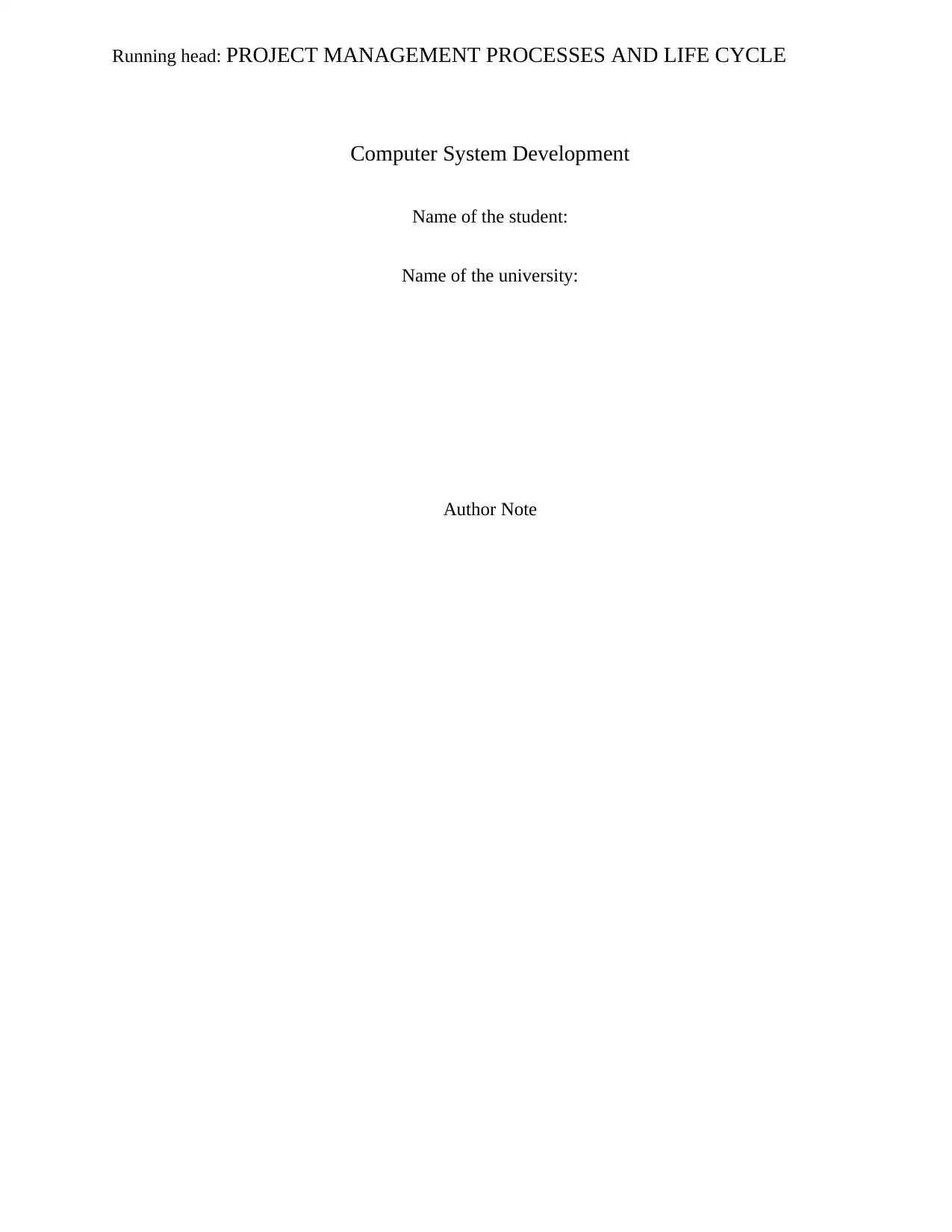
Running head: PROJECT MANAGEMENT PROCESSES AND LIFE CYCLE
Computer System Development
Name of the student:
Name of the university:
Author Note
Computer System Development
Name of the student:
Name of the university:
Author Note
Paraphrase This Document
Need a fresh take? Get an instant paraphrase of this document with our AI Paraphraser
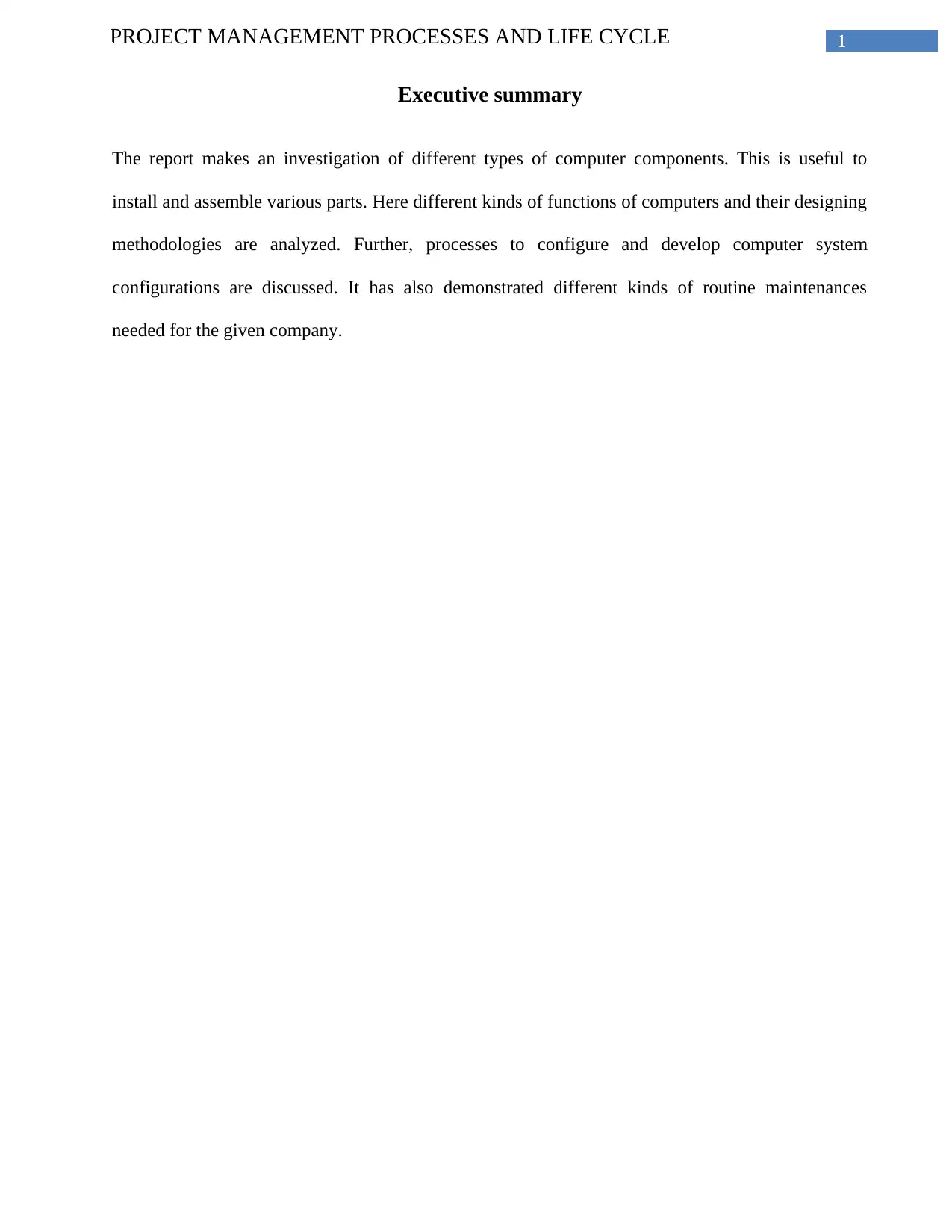
1PROJECT MANAGEMENT PROCESSES AND LIFE CYCLE
Executive summary
The report makes an investigation of different types of computer components. This is useful to
install and assemble various parts. Here different kinds of functions of computers and their designing
methodologies are analyzed. Further, processes to configure and develop computer system
configurations are discussed. It has also demonstrated different kinds of routine maintenances
needed for the given company.
Executive summary
The report makes an investigation of different types of computer components. This is useful to
install and assemble various parts. Here different kinds of functions of computers and their designing
methodologies are analyzed. Further, processes to configure and develop computer system
configurations are discussed. It has also demonstrated different kinds of routine maintenances
needed for the given company.
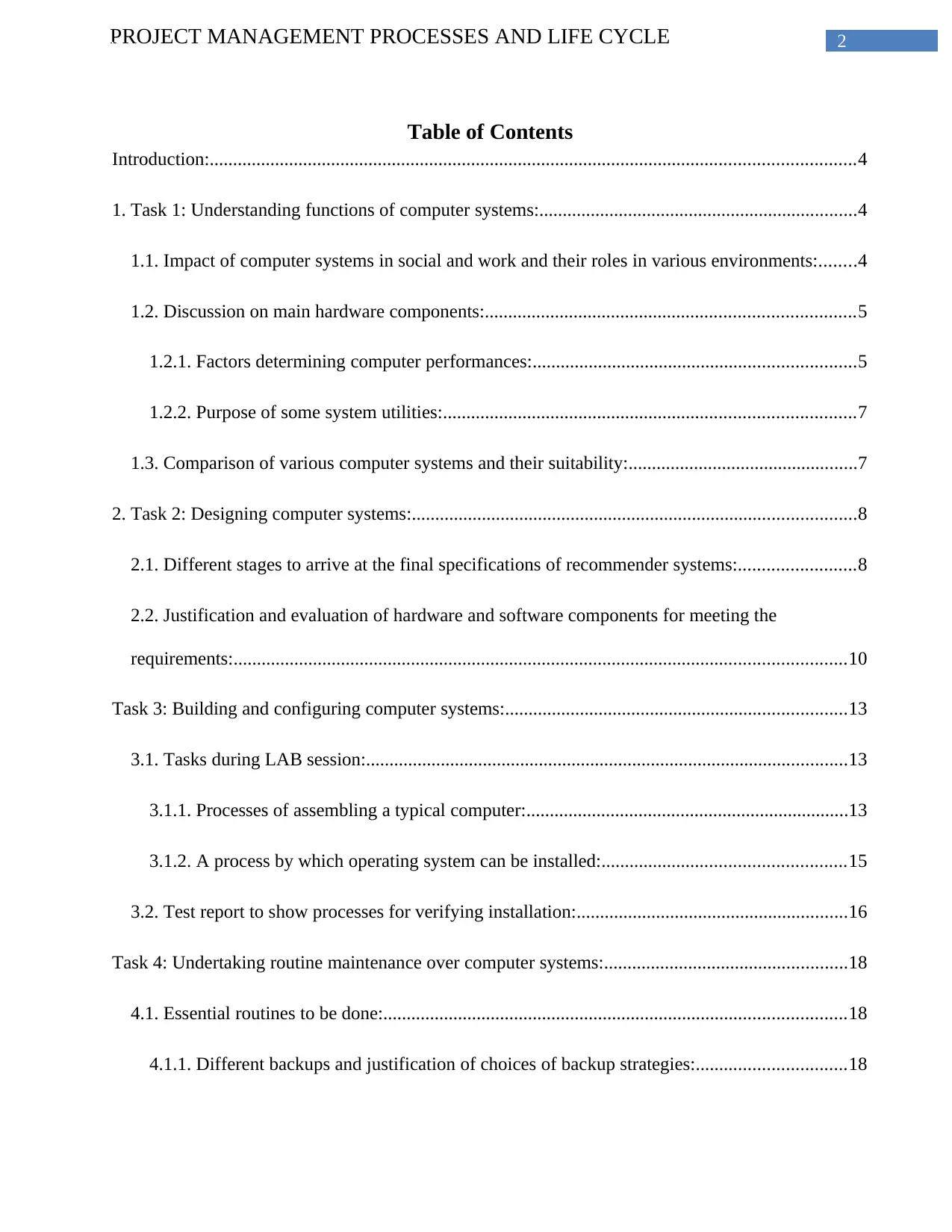
2PROJECT MANAGEMENT PROCESSES AND LIFE CYCLE
Table of Contents
Introduction:..........................................................................................................................................4
1. Task 1: Understanding functions of computer systems:....................................................................4
1.1. Impact of computer systems in social and work and their roles in various environments:........4
1.2. Discussion on main hardware components:...............................................................................5
1.2.1. Factors determining computer performances:.....................................................................5
1.2.2. Purpose of some system utilities:........................................................................................7
1.3. Comparison of various computer systems and their suitability:.................................................7
2. Task 2: Designing computer systems:...............................................................................................8
2.1. Different stages to arrive at the final specifications of recommender systems:.........................8
2.2. Justification and evaluation of hardware and software components for meeting the
requirements:...................................................................................................................................10
Task 3: Building and configuring computer systems:.........................................................................13
3.1. Tasks during LAB session:.......................................................................................................13
3.1.1. Processes of assembling a typical computer:.....................................................................13
3.1.2. A process by which operating system can be installed:....................................................15
3.2. Test report to show processes for verifying installation:..........................................................16
Task 4: Undertaking routine maintenance over computer systems:....................................................18
4.1. Essential routines to be done:...................................................................................................18
4.1.1. Different backups and justification of choices of backup strategies:................................18
Table of Contents
Introduction:..........................................................................................................................................4
1. Task 1: Understanding functions of computer systems:....................................................................4
1.1. Impact of computer systems in social and work and their roles in various environments:........4
1.2. Discussion on main hardware components:...............................................................................5
1.2.1. Factors determining computer performances:.....................................................................5
1.2.2. Purpose of some system utilities:........................................................................................7
1.3. Comparison of various computer systems and their suitability:.................................................7
2. Task 2: Designing computer systems:...............................................................................................8
2.1. Different stages to arrive at the final specifications of recommender systems:.........................8
2.2. Justification and evaluation of hardware and software components for meeting the
requirements:...................................................................................................................................10
Task 3: Building and configuring computer systems:.........................................................................13
3.1. Tasks during LAB session:.......................................................................................................13
3.1.1. Processes of assembling a typical computer:.....................................................................13
3.1.2. A process by which operating system can be installed:....................................................15
3.2. Test report to show processes for verifying installation:..........................................................16
Task 4: Undertaking routine maintenance over computer systems:....................................................18
4.1. Essential routines to be done:...................................................................................................18
4.1.1. Different backups and justification of choices of backup strategies:................................18
⊘ This is a preview!⊘
Do you want full access?
Subscribe today to unlock all pages.

Trusted by 1+ million students worldwide
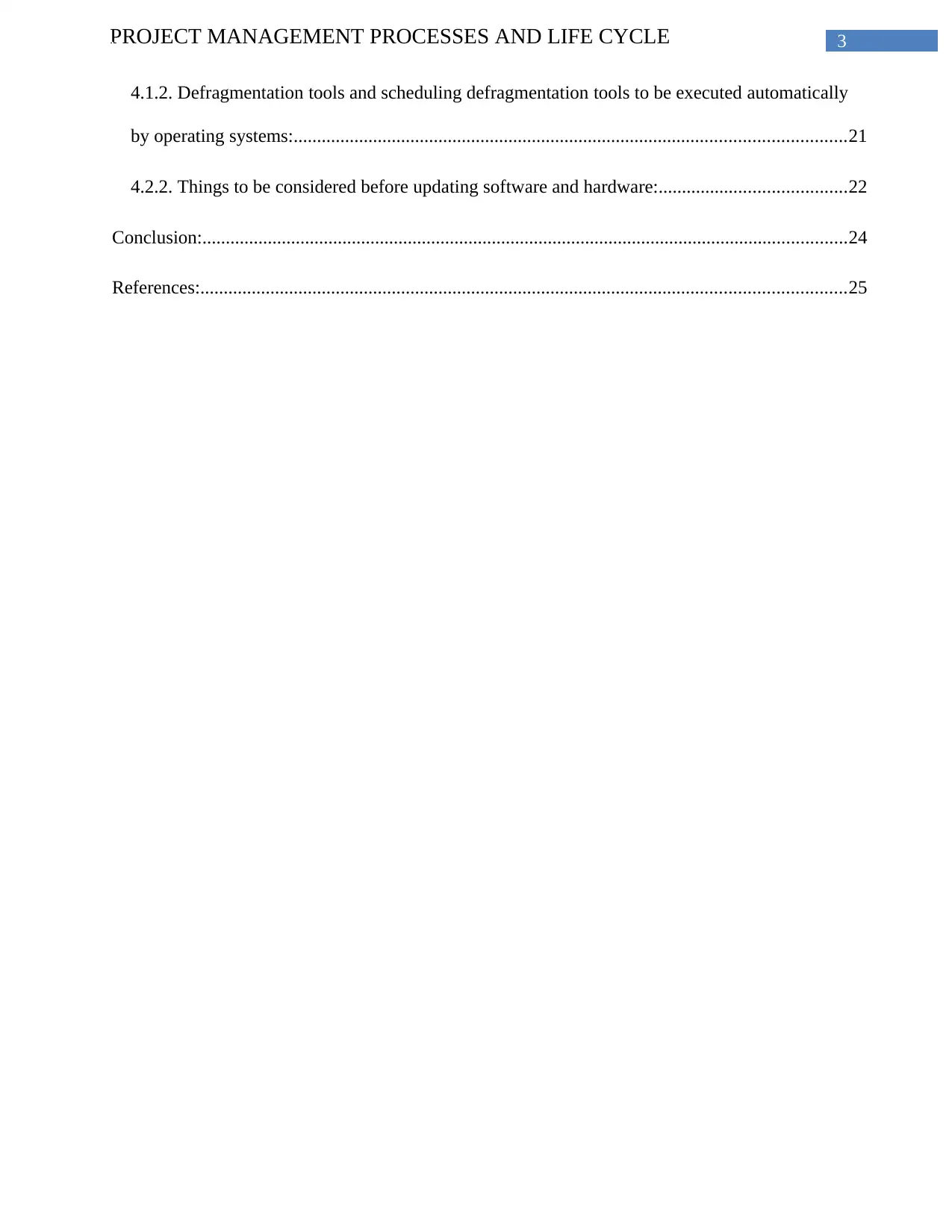
3PROJECT MANAGEMENT PROCESSES AND LIFE CYCLE
4.1.2. Defragmentation tools and scheduling defragmentation tools to be executed automatically
by operating systems:......................................................................................................................21
4.2.2. Things to be considered before updating software and hardware:........................................22
Conclusion:..........................................................................................................................................24
References:..........................................................................................................................................25
4.1.2. Defragmentation tools and scheduling defragmentation tools to be executed automatically
by operating systems:......................................................................................................................21
4.2.2. Things to be considered before updating software and hardware:........................................22
Conclusion:..........................................................................................................................................24
References:..........................................................................................................................................25
Paraphrase This Document
Need a fresh take? Get an instant paraphrase of this document with our AI Paraphraser
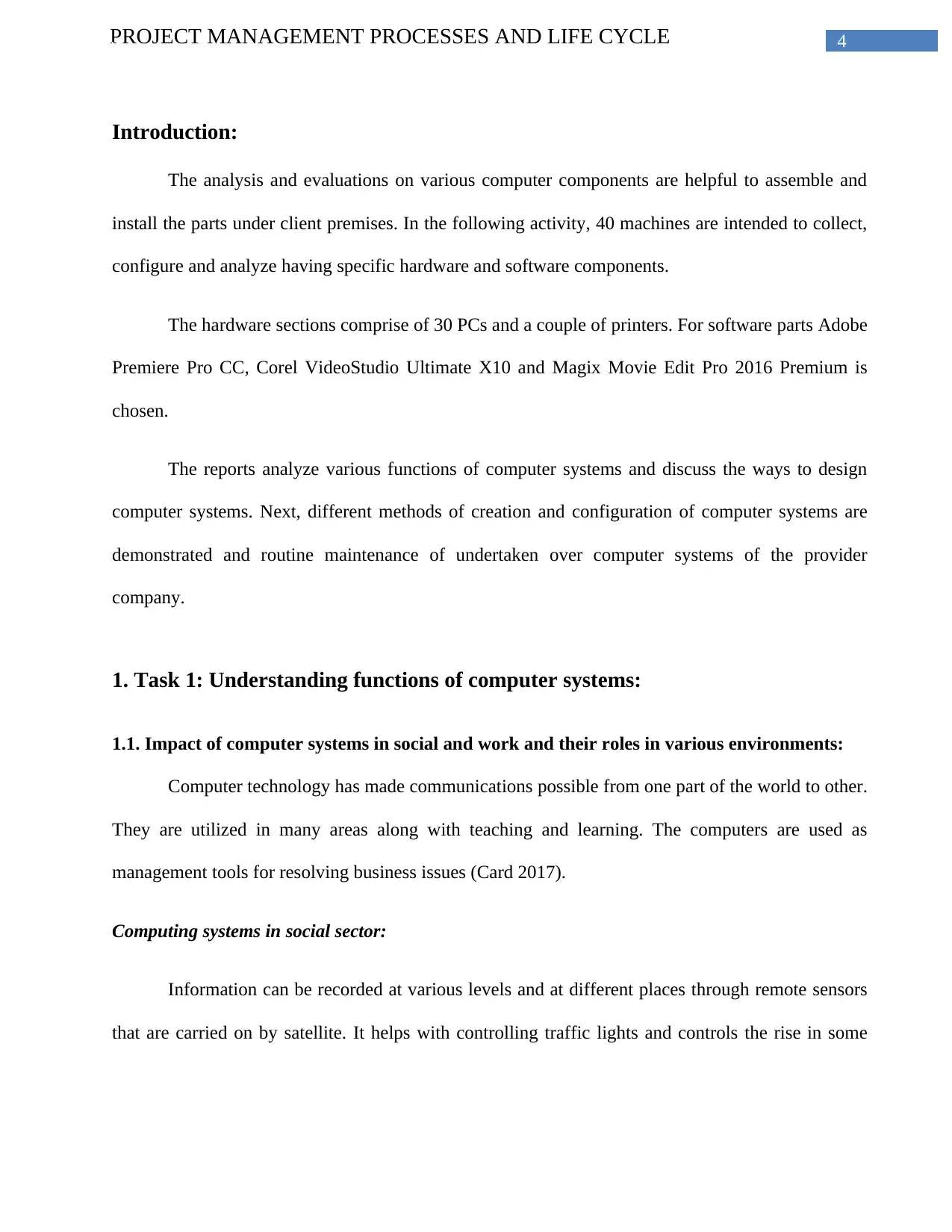
4PROJECT MANAGEMENT PROCESSES AND LIFE CYCLE
Introduction:
The analysis and evaluations on various computer components are helpful to assemble and
install the parts under client premises. In the following activity, 40 machines are intended to collect,
configure and analyze having specific hardware and software components.
The hardware sections comprise of 30 PCs and a couple of printers. For software parts Adobe
Premiere Pro CC, Corel VideoStudio Ultimate X10 and Magix Movie Edit Pro 2016 Premium is
chosen.
The reports analyze various functions of computer systems and discuss the ways to design
computer systems. Next, different methods of creation and configuration of computer systems are
demonstrated and routine maintenance of undertaken over computer systems of the provider
company.
1. Task 1: Understanding functions of computer systems:
1.1. Impact of computer systems in social and work and their roles in various environments:
Computer technology has made communications possible from one part of the world to other.
They are utilized in many areas along with teaching and learning. The computers are used as
management tools for resolving business issues (Card 2017).
Computing systems in social sector:
Information can be recorded at various levels and at different places through remote sensors
that are carried on by satellite. It helps with controlling traffic lights and controls the rise in some
Introduction:
The analysis and evaluations on various computer components are helpful to assemble and
install the parts under client premises. In the following activity, 40 machines are intended to collect,
configure and analyze having specific hardware and software components.
The hardware sections comprise of 30 PCs and a couple of printers. For software parts Adobe
Premiere Pro CC, Corel VideoStudio Ultimate X10 and Magix Movie Edit Pro 2016 Premium is
chosen.
The reports analyze various functions of computer systems and discuss the ways to design
computer systems. Next, different methods of creation and configuration of computer systems are
demonstrated and routine maintenance of undertaken over computer systems of the provider
company.
1. Task 1: Understanding functions of computer systems:
1.1. Impact of computer systems in social and work and their roles in various environments:
Computer technology has made communications possible from one part of the world to other.
They are utilized in many areas along with teaching and learning. The computers are used as
management tools for resolving business issues (Card 2017).
Computing systems in social sector:
Information can be recorded at various levels and at different places through remote sensors
that are carried on by satellite. It helps with controlling traffic lights and controls the rise in some
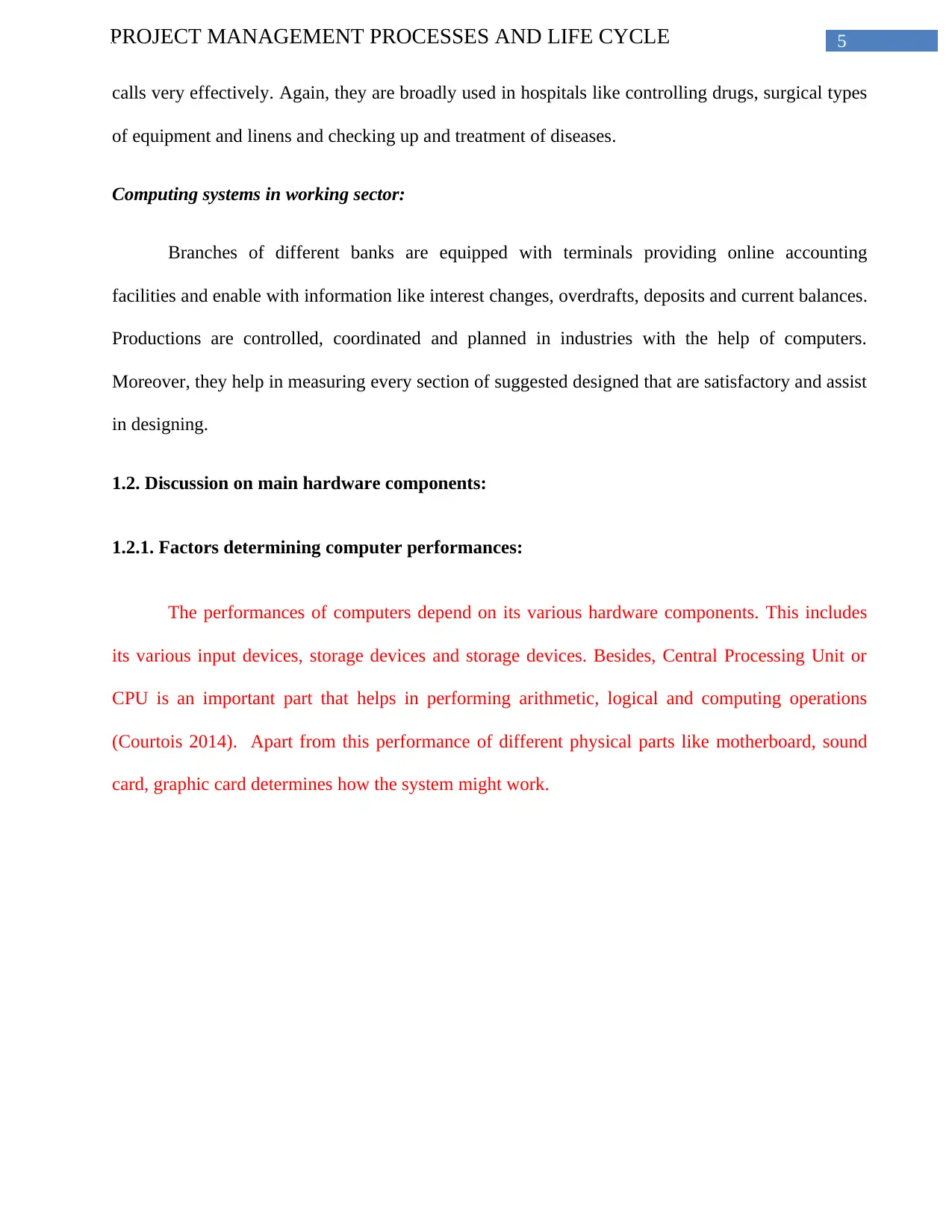
5PROJECT MANAGEMENT PROCESSES AND LIFE CYCLE
calls very effectively. Again, they are broadly used in hospitals like controlling drugs, surgical types
of equipment and linens and checking up and treatment of diseases.
Computing systems in working sector:
Branches of different banks are equipped with terminals providing online accounting
facilities and enable with information like interest changes, overdrafts, deposits and current balances.
Productions are controlled, coordinated and planned in industries with the help of computers.
Moreover, they help in measuring every section of suggested designed that are satisfactory and assist
in designing.
1.2. Discussion on main hardware components:
1.2.1. Factors determining computer performances:
The performances of computers depend on its various hardware components. This includes
its various input devices, storage devices and storage devices. Besides, Central Processing Unit or
CPU is an important part that helps in performing arithmetic, logical and computing operations
(Courtois 2014). Apart from this performance of different physical parts like motherboard, sound
card, graphic card determines how the system might work.
calls very effectively. Again, they are broadly used in hospitals like controlling drugs, surgical types
of equipment and linens and checking up and treatment of diseases.
Computing systems in working sector:
Branches of different banks are equipped with terminals providing online accounting
facilities and enable with information like interest changes, overdrafts, deposits and current balances.
Productions are controlled, coordinated and planned in industries with the help of computers.
Moreover, they help in measuring every section of suggested designed that are satisfactory and assist
in designing.
1.2. Discussion on main hardware components:
1.2.1. Factors determining computer performances:
The performances of computers depend on its various hardware components. This includes
its various input devices, storage devices and storage devices. Besides, Central Processing Unit or
CPU is an important part that helps in performing arithmetic, logical and computing operations
(Courtois 2014). Apart from this performance of different physical parts like motherboard, sound
card, graphic card determines how the system might work.
⊘ This is a preview!⊘
Do you want full access?
Subscribe today to unlock all pages.

Trusted by 1+ million students worldwide
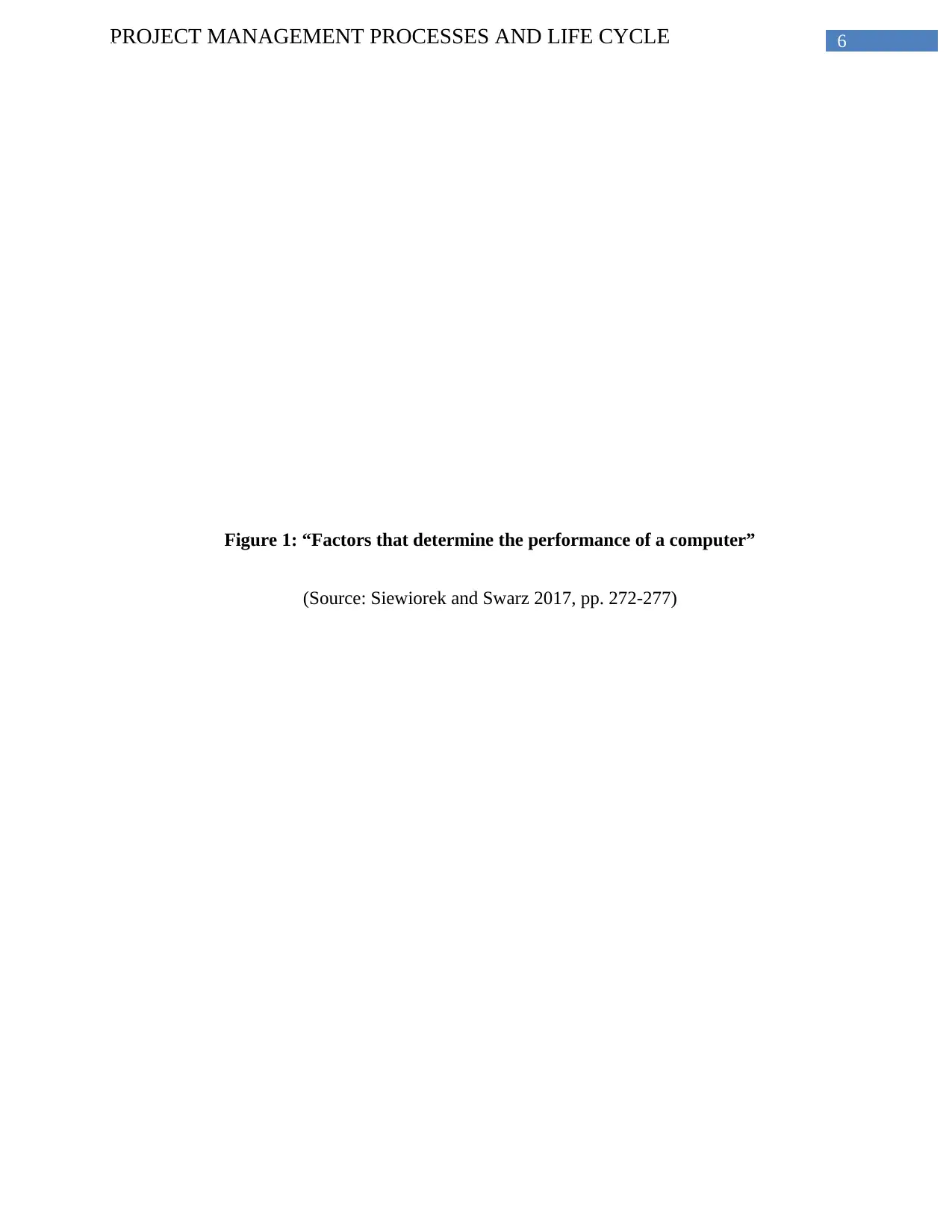
6PROJECT MANAGEMENT PROCESSES AND LIFE CYCLE
Figure 1: “Factors that determine the performance of a computer”
(Source: Siewiorek and Swarz 2017, pp. 272-277)
Figure 1: “Factors that determine the performance of a computer”
(Source: Siewiorek and Swarz 2017, pp. 272-277)
Paraphrase This Document
Need a fresh take? Get an instant paraphrase of this document with our AI Paraphraser
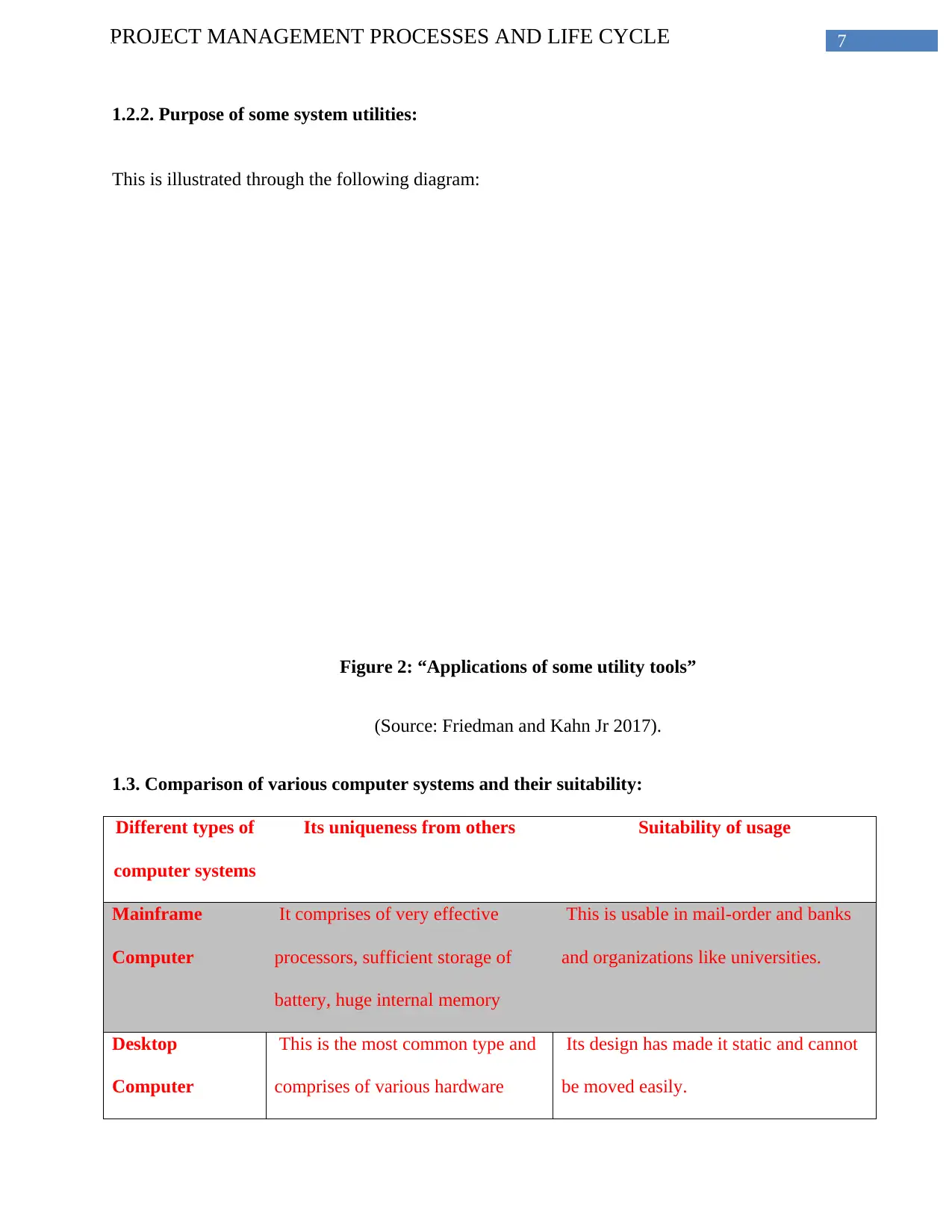
7PROJECT MANAGEMENT PROCESSES AND LIFE CYCLE
1.2.2. Purpose of some system utilities:
This is illustrated through the following diagram:
Figure 2: “Applications of some utility tools”
(Source: Friedman and Kahn Jr 2017).
1.3. Comparison of various computer systems and their suitability:
Different types of
computer systems
Its uniqueness from others Suitability of usage
Mainframe
Computer
It comprises of very effective
processors, sufficient storage of
battery, huge internal memory
This is usable in mail-order and banks
and organizations like universities.
Desktop
Computer
This is the most common type and
comprises of various hardware
Its design has made it static and cannot
be moved easily.
1.2.2. Purpose of some system utilities:
This is illustrated through the following diagram:
Figure 2: “Applications of some utility tools”
(Source: Friedman and Kahn Jr 2017).
1.3. Comparison of various computer systems and their suitability:
Different types of
computer systems
Its uniqueness from others Suitability of usage
Mainframe
Computer
It comprises of very effective
processors, sufficient storage of
battery, huge internal memory
This is usable in mail-order and banks
and organizations like universities.
Desktop
Computer
This is the most common type and
comprises of various hardware
Its design has made it static and cannot
be moved easily.
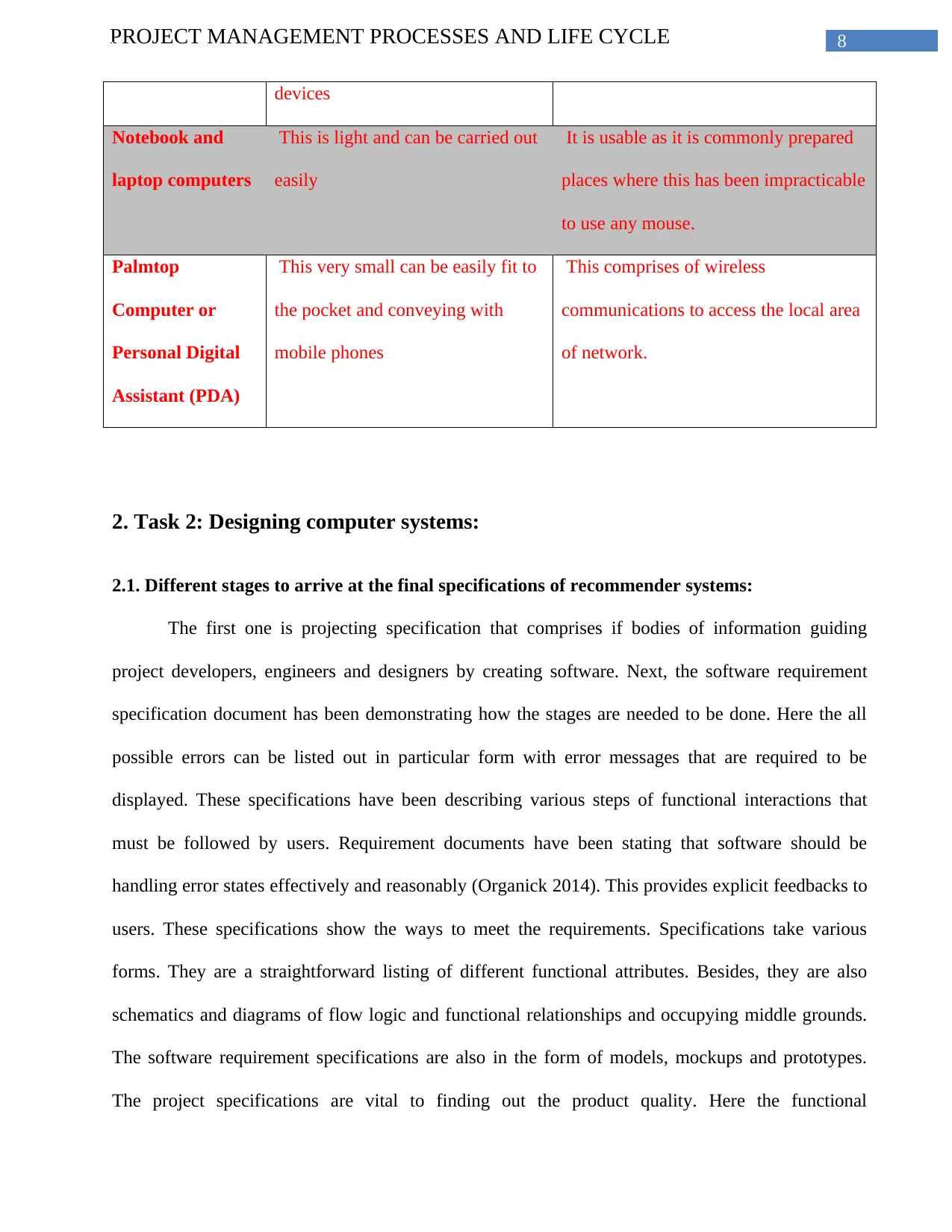
8PROJECT MANAGEMENT PROCESSES AND LIFE CYCLE
devices
Notebook and
laptop computers
This is light and can be carried out
easily
It is usable as it is commonly prepared
places where this has been impracticable
to use any mouse.
Palmtop
Computer or
Personal Digital
Assistant (PDA)
This very small can be easily fit to
the pocket and conveying with
mobile phones
This comprises of wireless
communications to access the local area
of network.
2. Task 2: Designing computer systems:
2.1. Different stages to arrive at the final specifications of recommender systems:
The first one is projecting specification that comprises if bodies of information guiding
project developers, engineers and designers by creating software. Next, the software requirement
specification document has been demonstrating how the stages are needed to be done. Here the all
possible errors can be listed out in particular form with error messages that are required to be
displayed. These specifications have been describing various steps of functional interactions that
must be followed by users. Requirement documents have been stating that software should be
handling error states effectively and reasonably (Organick 2014). This provides explicit feedbacks to
users. These specifications show the ways to meet the requirements. Specifications take various
forms. They are a straightforward listing of different functional attributes. Besides, they are also
schematics and diagrams of flow logic and functional relationships and occupying middle grounds.
The software requirement specifications are also in the form of models, mockups and prototypes.
The project specifications are vital to finding out the product quality. Here the functional
devices
Notebook and
laptop computers
This is light and can be carried out
easily
It is usable as it is commonly prepared
places where this has been impracticable
to use any mouse.
Palmtop
Computer or
Personal Digital
Assistant (PDA)
This very small can be easily fit to
the pocket and conveying with
mobile phones
This comprises of wireless
communications to access the local area
of network.
2. Task 2: Designing computer systems:
2.1. Different stages to arrive at the final specifications of recommender systems:
The first one is projecting specification that comprises if bodies of information guiding
project developers, engineers and designers by creating software. Next, the software requirement
specification document has been demonstrating how the stages are needed to be done. Here the all
possible errors can be listed out in particular form with error messages that are required to be
displayed. These specifications have been describing various steps of functional interactions that
must be followed by users. Requirement documents have been stating that software should be
handling error states effectively and reasonably (Organick 2014). This provides explicit feedbacks to
users. These specifications show the ways to meet the requirements. Specifications take various
forms. They are a straightforward listing of different functional attributes. Besides, they are also
schematics and diagrams of flow logic and functional relationships and occupying middle grounds.
The software requirement specifications are also in the form of models, mockups and prototypes.
The project specifications are vital to finding out the product quality. Here the functional
⊘ This is a preview!⊘
Do you want full access?
Subscribe today to unlock all pages.

Trusted by 1+ million students worldwide
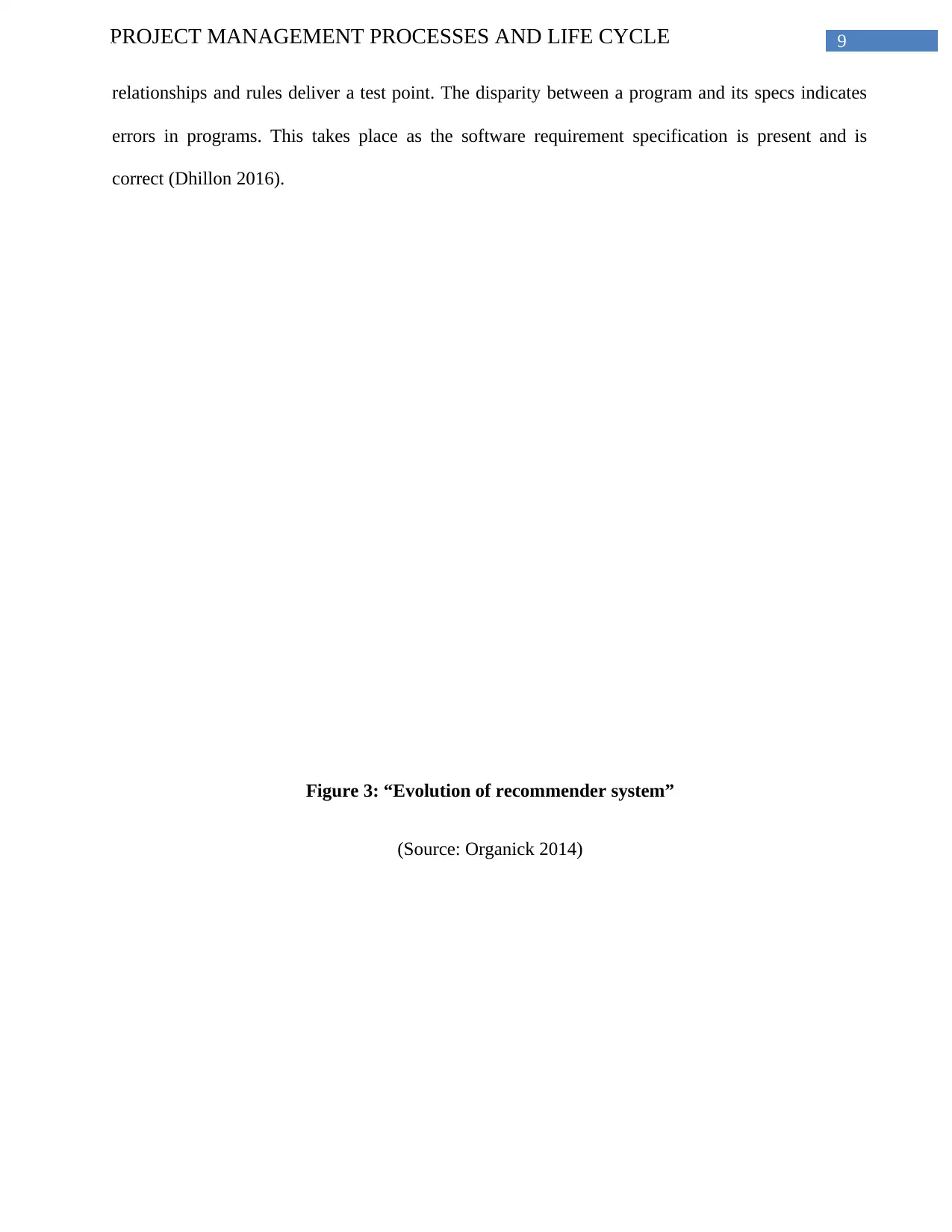
9PROJECT MANAGEMENT PROCESSES AND LIFE CYCLE
relationships and rules deliver a test point. The disparity between a program and its specs indicates
errors in programs. This takes place as the software requirement specification is present and is
correct (Dhillon 2016).
Figure 3: “Evolution of recommender system”
(Source: Organick 2014)
ItemhierarchyCollaborativefiltering(User-usesimilarity)Socialandinterest,graphbased
relationships and rules deliver a test point. The disparity between a program and its specs indicates
errors in programs. This takes place as the software requirement specification is present and is
correct (Dhillon 2016).
Figure 3: “Evolution of recommender system”
(Source: Organick 2014)
ItemhierarchyCollaborativefiltering(User-usesimilarity)Socialandinterest,graphbased
Paraphrase This Document
Need a fresh take? Get an instant paraphrase of this document with our AI Paraphraser
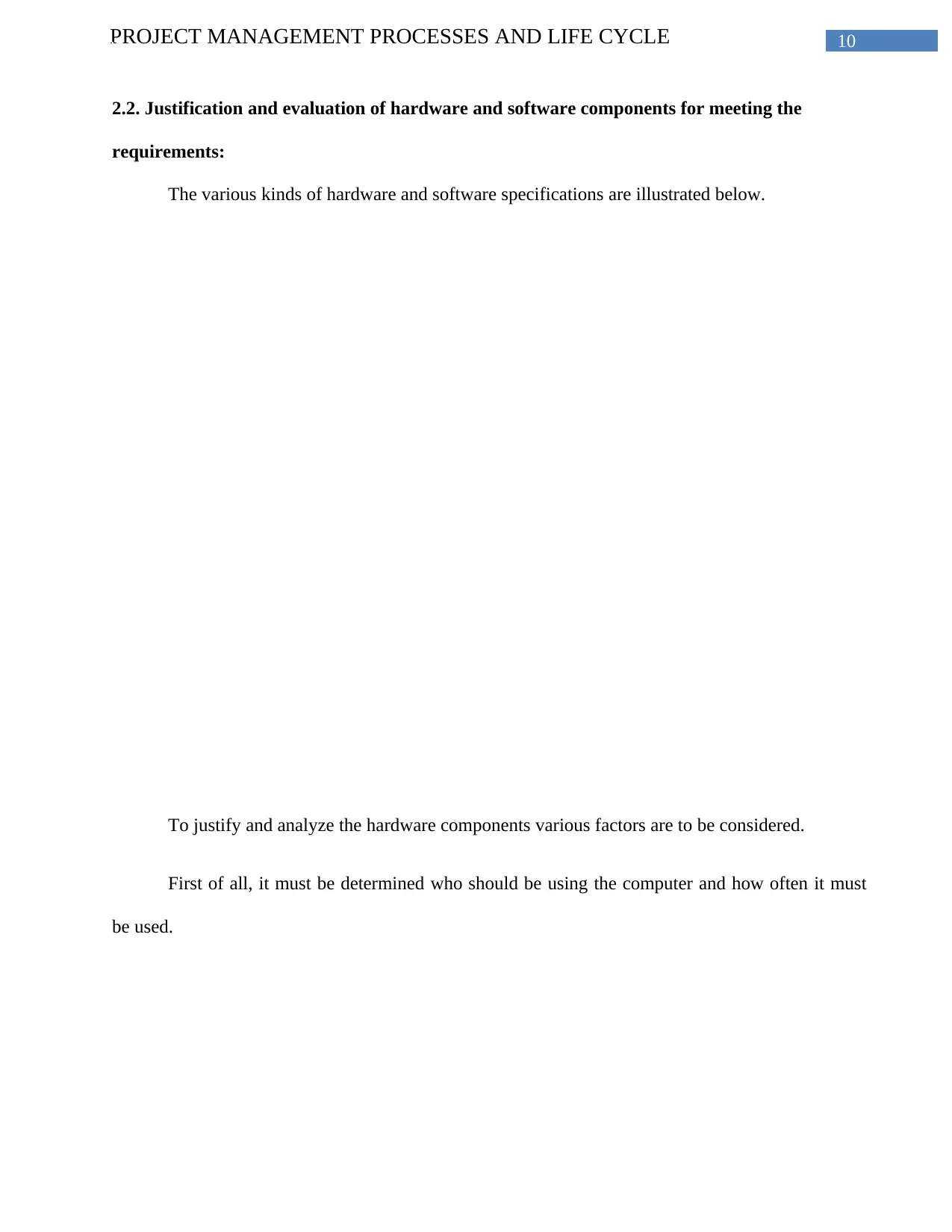
10PROJECT MANAGEMENT PROCESSES AND LIFE CYCLE
2.2. Justification and evaluation of hardware and software components for meeting the
requirements:
The various kinds of hardware and software specifications are illustrated below.
To justify and analyze the hardware components various factors are to be considered.
First of all, it must be determined who should be using the computer and how often it must
be used.
CPU:Intel®Core™i7-6800KProcessor(15MCache,upto3.60GHz)GraphicsCard:MSIGTX10502GOCMotherboard:ASUSROGSTRIXZ270FRAM:32GBDDR4PowerSupply:EVGAG2750WOperatingSystem:Windows10Printer–Laserjetprinter
2.2. Justification and evaluation of hardware and software components for meeting the
requirements:
The various kinds of hardware and software specifications are illustrated below.
To justify and analyze the hardware components various factors are to be considered.
First of all, it must be determined who should be using the computer and how often it must
be used.
CPU:Intel®Core™i7-6800KProcessor(15MCache,upto3.60GHz)GraphicsCard:MSIGTX10502GOCMotherboard:ASUSROGSTRIXZ270FRAM:32GBDDR4PowerSupply:EVGAG2750WOperatingSystem:Windows10Printer–Laserjetprinter
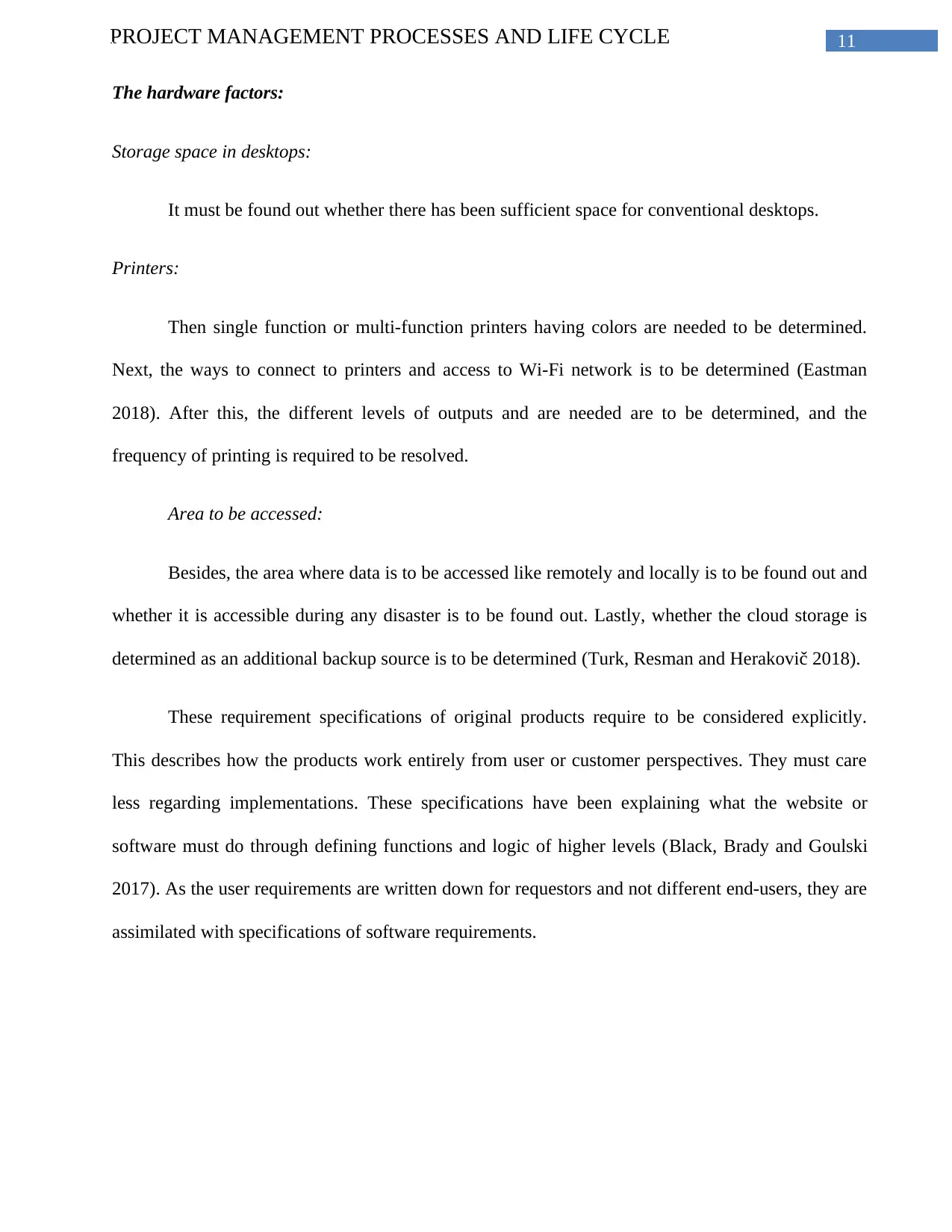
11PROJECT MANAGEMENT PROCESSES AND LIFE CYCLE
The hardware factors:
Storage space in desktops:
It must be found out whether there has been sufficient space for conventional desktops.
Printers:
Then single function or multi-function printers having colors are needed to be determined.
Next, the ways to connect to printers and access to Wi-Fi network is to be determined (Eastman
2018). After this, the different levels of outputs and are needed are to be determined, and the
frequency of printing is required to be resolved.
Area to be accessed:
Besides, the area where data is to be accessed like remotely and locally is to be found out and
whether it is accessible during any disaster is to be found out. Lastly, whether the cloud storage is
determined as an additional backup source is to be determined (Turk, Resman and Herakovič 2018).
These requirement specifications of original products require to be considered explicitly.
This describes how the products work entirely from user or customer perspectives. They must care
less regarding implementations. These specifications have been explaining what the website or
software must do through defining functions and logic of higher levels (Black, Brady and Goulski
2017). As the user requirements are written down for requestors and not different end-users, they are
assimilated with specifications of software requirements.
The hardware factors:
Storage space in desktops:
It must be found out whether there has been sufficient space for conventional desktops.
Printers:
Then single function or multi-function printers having colors are needed to be determined.
Next, the ways to connect to printers and access to Wi-Fi network is to be determined (Eastman
2018). After this, the different levels of outputs and are needed are to be determined, and the
frequency of printing is required to be resolved.
Area to be accessed:
Besides, the area where data is to be accessed like remotely and locally is to be found out and
whether it is accessible during any disaster is to be found out. Lastly, whether the cloud storage is
determined as an additional backup source is to be determined (Turk, Resman and Herakovič 2018).
These requirement specifications of original products require to be considered explicitly.
This describes how the products work entirely from user or customer perspectives. They must care
less regarding implementations. These specifications have been explaining what the website or
software must do through defining functions and logic of higher levels (Black, Brady and Goulski
2017). As the user requirements are written down for requestors and not different end-users, they are
assimilated with specifications of software requirements.
⊘ This is a preview!⊘
Do you want full access?
Subscribe today to unlock all pages.

Trusted by 1+ million students worldwide
1 out of 29
Related Documents
Your All-in-One AI-Powered Toolkit for Academic Success.
+13062052269
info@desklib.com
Available 24*7 on WhatsApp / Email
![[object Object]](/_next/static/media/star-bottom.7253800d.svg)
Unlock your academic potential
Copyright © 2020–2025 A2Z Services. All Rights Reserved. Developed and managed by ZUCOL.





